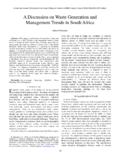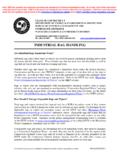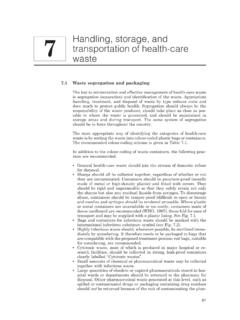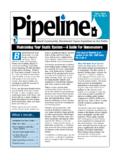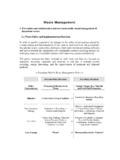Transcription of WASTE MANAGEMENT - United Nations
1 The Swiss Confederation national Reporting to CSD 18/19 by Switzerland 1 | Page WASTE MANAGEMENT 1. Overview The tradition of developing and using environmental technologies especially for WASTE MANAGEMENT has existed in Switzerland for a long time. As early as the 1960s the country became a pioneer in this domain by rigorously installing treatment and incineration plants with stringent emission standards. Today it can be acknowledged that Switzerland has succeeded in moving from basic WASTE removal to an environmentally friendly process of WASTE disposal and recycling. Now, incineration plants are efficient power plants which produce clean heat and electricity. However, Switzerland will soon be faced with new considerable challenges which it will not be able to master alone. If the objective is to sensibly reduce the environmental impacts due to the huge flow of goods worldwide, it will not be sufficient to act at the end of the production supply chain.
2 Therefore, in order to work towards sustainable development, it will be even more necessary to improve social and environmental criteria all along the life cycle of goods and services. Municipal solid WASTE From year to year municipal solid WASTE (MSW) arisings in Switzerland have been on the increase. By 2007 they had reached 720 kg per person. Today, half of all MSW arisings are collected separately and recovered a ratio that has more than doubled over the past 20 years. The recycling principle was also applied very swiftly everywhere and Swiss recycling rates are among the highest in the world. The remaining wastes are incinerated in clean processes which generate electricity and heat, meeting some 2 % of the country s final energy requirements. In recent years, the Swiss Confederation s WASTE MANAGEMENT policy has significantly reduced the level of environmental pressure caused by WASTE MANAGEMENT despite continuous growth in the total volume of MSW arisings.
3 This trend can be attributed to the introduction of high WASTE MANAGEMENT standards, to a highly effective infrastructure, and to a financing system that makes the WASTE producers responsible for the costs of disposal. Nonetheless, even a highly effective WASTE policy is by itself insufficient in reducing the country s overall consumption of resources. national Reporting to CSD 18/19 by Switzerland WASTE MANAGEMENT 2 | Page Hazardous wastes Hazardous WASTE thus accounts for about 6 % of all WASTE . Each year around million tonnes hazardous wastes are consigned to special reprocessing, are disposed of within the country, or are exported in line with the provisions of the Basel Convention on the Control of Transboundary Movements of Hazardous Wastes and Their Disposal. Unless appropriately managed, hazardous WASTE poses risks to the environment. The remediation of disused hazardous WASTE landfill sites will cost the Swiss economy well over 1 billion francs.
4 2. Prevention and minimization and environmentally sound MANAGEMENT of hazardous wastes Since 2000, the total volume of hazardous WASTE in Switzerland has been approximately million tonnes per year. Hazardous WASTE thus accounts for about 6 % of all WASTE . In 2005, 43 % of the hazardous WASTE was incinerated, 22 % was landfilled after appropriate pretreatment, 23 % underwent chemical/physical treatment and 12 % was directly recycled. Chemical/physical treatment takes place mainly in Switzerland. This approach is applied to polluted wastewater, soil from contaminated site remediation and emulsions. The disposal of hazardous WASTE , which came into force in 2006, is regulated by the Ordinance on Movements of WASTE (VeVA1). The objectives concerning the disposal of hazardous WASTE are as follows: avoid their production, recycle them wherever possible, treat those that are not recyclable so that they can be deposited in landfills in an eco-compatible manner, and dispose of them mainly in Switzerland.
5 The accomplishment of these objectives resulted in the creation of an efficient disposal infrastructure in Switzerland, and the establishment of an infallible legislation on hazardous WASTE flows. Industry in particular has improved its MANAGEMENT of hazardous WASTE by taking measures to prevent it and to recycle unavoidable WASTE more efficiently. Recycling of hazardous WASTE The recycling of hazardous WASTE is being promoted by the implementation of the Ordinance on Movements of WASTE and Technical Ordinance on WASTE , the development of new treatment methods and rising raw material prices. Cement plants In 2008, there were 6 cement plants operating in Switzerland, producing close to million tonnes of cement. The production of 1 tonne of clinker requires about 135 kg of coal or 86 kg of heavy oil. In principle, cement plants can use suitable types of WASTE as an alternative fuel or raw material. However, this must not increase the emission of air pollutants from kilns or reduce the quality of the cement produced.
6 Accordingly, guidelines on disposal of wastes in cement plants were developed2 in close collaboration with the industry and the cantonal authorities. 1 VeVA: 2 Guidelines: national Reporting to CSD 18/19 by Switzerland WASTE MANAGEMENT 3 | Page These guidelines prohibit the incineration in cement plants of municipal WASTE and problematic special wastes ( chlorinated solvents or paint residues with a high heavy metal content). However, bulk wastes with a low pollution potential and high calorific value - such as used oil, sewage sludge, animal flour/animal fat, low-chlorinated solvents, plastics, used tyres etc. - may be used as alternative fuels. In 2008, the cement plants consumed a total of approximately 270 000 tonnes of combustible WASTE and 250 000 tonnes of alternative raw materials. WASTE disposal facilities Requirements for disposal facilities are specified in the Technical Ordinance on WASTE (TVA3).
7 It specifies stringent requirements for WASTE that is to be landfilled. Today, three different types of landfill site exist in Switzerland, corresponding to different types of WASTE : Landfills for inert materials: only rock-like wastes may be disposed of, from which virtually no pollutants will be leached out by rainwater. These include materials such as construction WASTE (concrete, bricks, glass, road rubble) and uncontaminated soil that cannot be used elsewhere. At suitable locations, landfills for inert materials do not require any special sealing. Landfills for stabilized residues: are designed for the disposal of materials of known composition, with high concentrations of heavy metals and only a small organic component, and which cannot release either gases or substances readily soluble in water. Typical materials include solidified fly ash and flue gas cleaning residues from municipal WASTE incinerators, and vitrified treatment residues.
8 These sites are subject to more stringent requirements than landfills for inert materials. Impermeable linings are required for the base and sides of the landfill, and leachate is to be collected and, if necessary, treated. Bioreactor landfills: chemical and biological processes are expected to occur. At these sites, drainage controls are also required. In addition, any gases emitted are to be captured and treated. Given the unpredictable composition of their contents, bioreactor landfills are at greatest risk of requiring expensive remediation at a later date. Certain types of WASTE ( incinerator slag) are required to be disposed of in separate compartments, isolated from other types of WASTE . If these wastes were intermixed, heavy metals would be leached out in much greater quantities as a result of the relatively low pH of incinerator slag. Compartments for residual wastes have also been established at numerous bioreactor landfill sites.
9 Bioreactor landfills require long-term efforts to monitor and treat gases and contaminated leachate. The processes occurring within the landfill continue for decades and cannot, in the event of an incident, be "switched off" within a matter of hours like the furnace of a municipal WASTE incinerator. Over a period of decades, despite the use of gas capture systems, substantial amounts of methane and other undesirable gases are released into the atmosphere from bioreactor landfills. 3 TVA Technical Ordinance on WASTE : national Reporting to CSD 18/19 by Switzerland WASTE MANAGEMENT 4 | Page There is also a non-negligible risk of defects in sealing systems leading to contamination of groundwater. These crucial factors underlie the prohibition on the direct landfilling of municipal WASTE , sewage sludge and other types of combustible WASTE which came into effect on 2000.
10 At the end of 2002, the total capacity available at bioreactor landfill sites was about million cubic metres, including million for incinerator slag. At landfills for stabilized residues, Switzerland has a reserve capacity of about million cubic metres. With annual disposal volumes of just under 500 000 cubic metres of slag and 50 000 cubic metres of residual wastes, this capacity is sufficient for more than 25 years. With regard to reserve capacity at the inert-material landfills operating in this country, the data available are incomplete at present. Even if sufficient capacity is available overall, there is a lack of space for landfilling in geologically unfavourable regions. As a result of the rapid growth in WASTE streams, cantonal authorities will be forced to continue reviewing their landfill planning in a coordinated fashion. In addition, appropriate funding of landfill maintenance and aftercare will become increasingly important in future.










